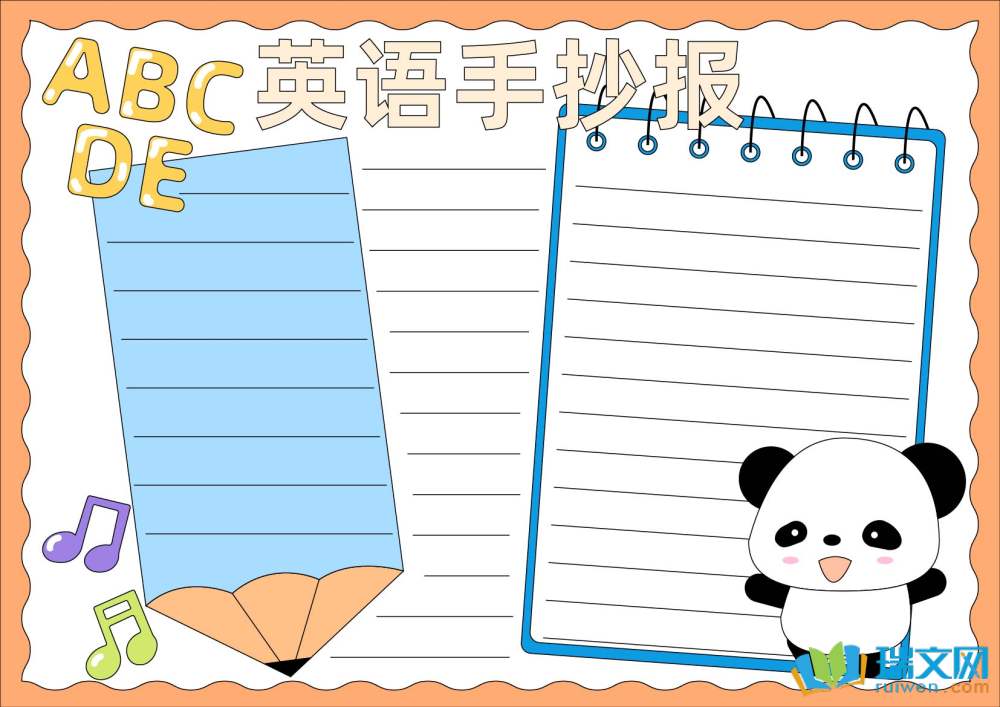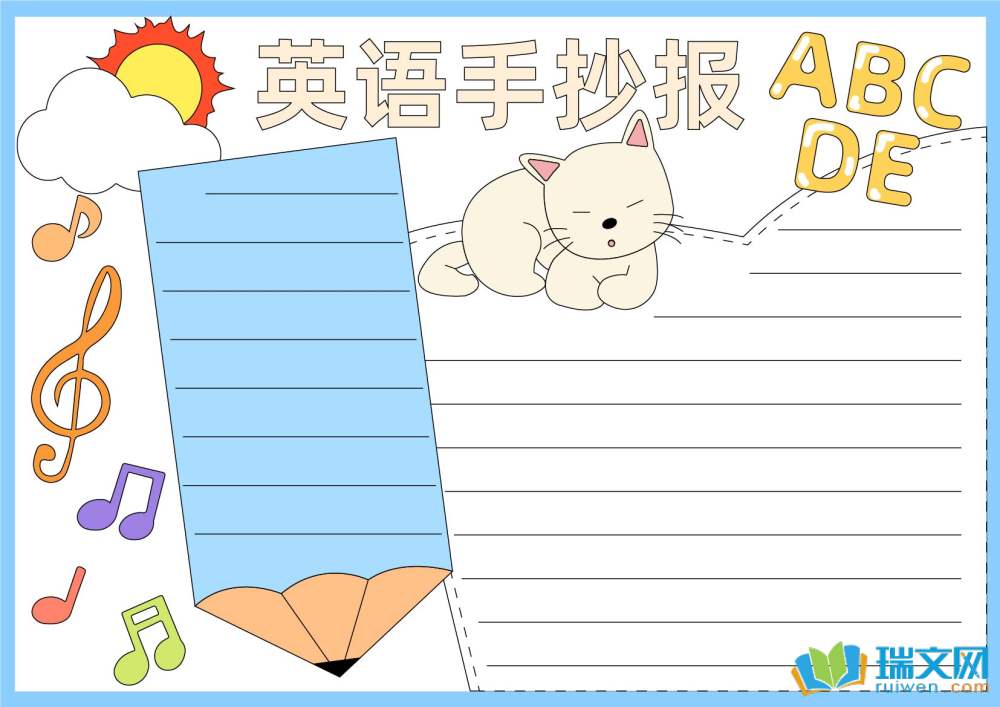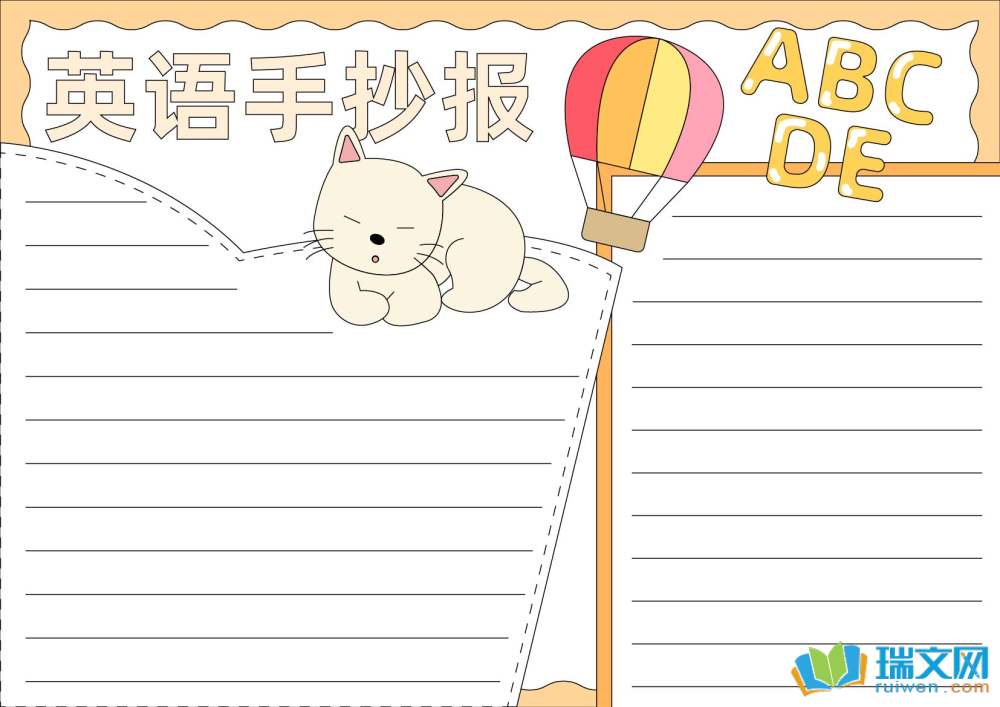- 相關(guān)推薦
小學(xué)生英語(yǔ)手抄報資料
小朋友們,大家知道哪些日常英語(yǔ)口語(yǔ)對話(huà)以及英語(yǔ)主要句型?下面就是收集相關(guān)的英語(yǔ)手抄報資料內容,歡迎大家閱讀!
小學(xué)生英語(yǔ)手抄報資料





1. Hello, … 你好。
2. Hi, … 喂,你好。
3. Good morning/ afternoon/evening. 早上/下午/晚上好。
4. How are you(this morning/afternoon/evening)? 你今天早晨/下午/晚上好嗎?
5. Fine, thank you/ thanks. 我很好,謝謝。
6. Not bad, thank you. 不錯,謝謝。
7. Welcome back to school. 歡迎回到學(xué)校來(lái)。
8. Welcome to our school. 歡迎到我們學(xué)校來(lái)。
9. Happy birthday! 生日快樂(lè )!
10. What’s your name, please? 你的名字是什么?
11. Your name, please? 你叫什么名字?
12. My name is…/ I’m… 我的名字是…/ 我名叫…
13. This is Miss/ Mr/ Mrs… 這位是…小姐/先生/女士。
14. This is my friend. 這是我的朋友。
15. Come and meet my friends. 過(guò)來(lái)見(jiàn)見(jiàn)我的朋友們。
16. How do you do? 你好。
17. Nice to meet /see you. 很高興認識/見(jiàn)到你。
18. Goodbye. 再見(jiàn) 19. Good night. 晚安。
20. How old is he? 他多大了?
第一冊
1、I am …. She ’s …. We ’re …. They ’re ….
I am Tom. She ’s my friend. We’re friends. They’re friends.
2、This is •••. This is Tom . This is a dog.
3、Give me … Give me a ruler . Give me some pens.
4、What’s this /that ? It’s a •••
5、What does •••do ? She’s/He’s •••.
What does she do ? What does your mother do ? She’s a nurse.
6、How many ••• can you see ? I can see …
How many cars can you see ? I can see two cars .
7、Is this a •••? Yes ,it is ./ No ,it isn’t .
Is this a duck ?
8、May I have …? Yes ,here you are .
May I have a pear ?
May I have eight apples ?
9、How are you ? Fine ,thank you .
10、Point to …. Point to the blackboard.
11、Come to …. Come to the blackboard.
12、Draw …. Draw an apple.
13、Look at …. Look at the blackboard.
第二冊
1、 What’s your name? My name’s•••.
2、 Are you •••? Yes, I am. /No, I’m not. Yes, we are. /No, we’re not.
Are you a new student?
Are you Amy and Lucy?
3、 Nice to meet you. Nice to meet you, too.
4、 Are they •••? Yes, they are. /No, they aren’t.
Are they Amy and Lucy?
5、 Who’s that? That’s my •••.
Who’s that? That’s my father.
6、 Is she •••? Yes, she is. /No, she isn’t.
Is she your sister?
7、 Is he •••? Yes, he is. /No, he isn’t.
Is he your brother?
8、How old •••?
How old are you? I’m ten.
How old is he ? He’s ten.
How old are they? They’re ten.
9、What’s the time? It’s four o’clock.
10、Thanks. /Thank you. Not at all.
11、These are•••. Those are•••.
These are trains. Those are planes.
12、What are these/those? They’re •••.
What are these? They’re books.
What are those? They’re pens.
13、What colour is ••• ? It’s ••• .
What colour is the plane? It’s blue.
14、What colour are ••• ? They’re •••.
What colour are the planes? They’re blue.
15、Where is ••• ? It’s •••.
Where is the football? It’s in the box.
16、Where are ••• ? They’re •••.
Where are the footballs ? They’re in the box.
17、 How many •••are there •••? There is•••. / There are •••.
How many doors are there in the classroom?
There is a (one ) door in the classroom.
There are two doors in the classroom..
There be 結構主要用以表達"某處(某時(shí))有某人(某物)",其基本句型為"There be + 某物或某人 + 某地或某時(shí)",其中there 是引導詞,沒(méi)有詞義;be是謂語(yǔ)動(dòng)詞;"某人或某物"是句子的主語(yǔ);"某地或某時(shí)"作句子的狀語(yǔ),多是介詞短語(yǔ)。如:
There is a football under the chair. 椅子下面有一個(gè)足球。
主語(yǔ)是不可數名詞或單數可數名詞時(shí)用is, 是復數時(shí)用are。如:
There is a flower in the bottle. 瓶里有一朵花。
There is some money in the purse. 錢(qián)包里有些錢(qián)。
2. 若句子中有幾個(gè)并列的主語(yǔ)時(shí),be的形式依據”就近原則”。如:
There is a boy, a girl and two women in the house. 房子里有一個(gè)男孩,一個(gè)女孩和兩個(gè)婦女。
There are ten students and a teacher in the office. 辦公室里有十個(gè)學(xué)生和一個(gè)教師。
3. 另外,在陳述句中為了強調地點(diǎn),也可將介詞短語(yǔ)提置句首。如:
In the tree there are five birds. 樹(shù)上有五只鳥(niǎo)。
There be 結構的句型轉換
否定句
there be的否定式通常在be后加not構成(在口語(yǔ)中be時(shí)常與not縮寫(xiě)在一起)。如果句中有some,一般要變成any。如:
There are some children in the picture. →There aren't any children in the picture.
一般疑問(wèn)句及其答語(yǔ)
把be提到there前,首字母大寫(xiě),句末用問(wèn)號即可。其肯定答語(yǔ)是Yes, there is / are;否定答語(yǔ)為No, there isn't / aren't。如:
—Are there two cats in the tree?
—Yes, there are. (No, there aren't.)
特殊疑問(wèn)句及其回答
①提問(wèn)句子的主語(yǔ)(包括主語(yǔ)前的'修飾語(yǔ))時(shí),句型一律用"what is + 地點(diǎn)介詞短語(yǔ)?"(無(wú)論主語(yǔ)是單數還是復數都用is)。如:
There are some birds in the tree. →What's in the tree?
②就there be后面的地點(diǎn)狀語(yǔ)進(jìn)行提問(wèn)時(shí),句型用"where is / are + 主語(yǔ)?"如:
There is a car in the street. →Where is the car?
③提問(wèn)可數名詞(主語(yǔ))前的數量時(shí),用how many,句型結構為"how many + 復數名詞 + are there + 其它?"(主語(yǔ)無(wú)論是單數還是復數,be通常要用are)。
18、Is there •••? Yes, there is. / No, there aren’t.
Is there a playground in the school?
19、Are there ••• ? Yes, there are. /No, there aren’t.
Are there any flowers in the garden?
20、Whose ••• is ••• ? It’s •••.
Whose blouse is this? It’s Mary’s blouse.
21、Whose blouses •••? They’re •••.
Whose blouses are these? They’re Mary’s blouses.
22、I ( don’t ) have •••. I ( don’t ) have a fork.
You ( don’t ) have •••. You ( don’t ) have a spoon.
We ( don’t ) have •••. We ( don’t ) have two bowls.
They ( don’t ) have •••. They ( don’t ) have two glasses.
23、Do you have •••? Yes, I do. Yes, we do. / No, I don’t. No, we don’t.
Do you have a fork?
24、Do they have •••? Yes, they do. /No, they don’t.
Do they have a fork?
25、He / She has •••. He / She has a new room.
He / She doesn’t have •••. He /She doesn’t have a new room.
26、Does he /she have •••? Yes, he /she does. No, he/she doesn’t.
Does he/she have a radio?
27、How many ••• does ••• have? He/She has •••.
How many sisters does Lucy have? She has one.
28、How many ••• do ••• have? I/We/They/You have •••.
How many sisters do you have? I have two.
【小學(xué)生英語(yǔ)手抄報資料】相關(guān)文章:
英語(yǔ)手抄報資料09-11
英語(yǔ)手抄報資料翻譯05-23
關(guān)于童話(huà)的英語(yǔ)手抄報資料03-19
國慶節手抄報資料英語(yǔ)10-08
母親節英語(yǔ)手抄報資料05-09
國慶節英語(yǔ)手抄報資料10-12
小學(xué)生語(yǔ)文手抄報資料04-30
英語(yǔ)春節的手抄報資料03-22